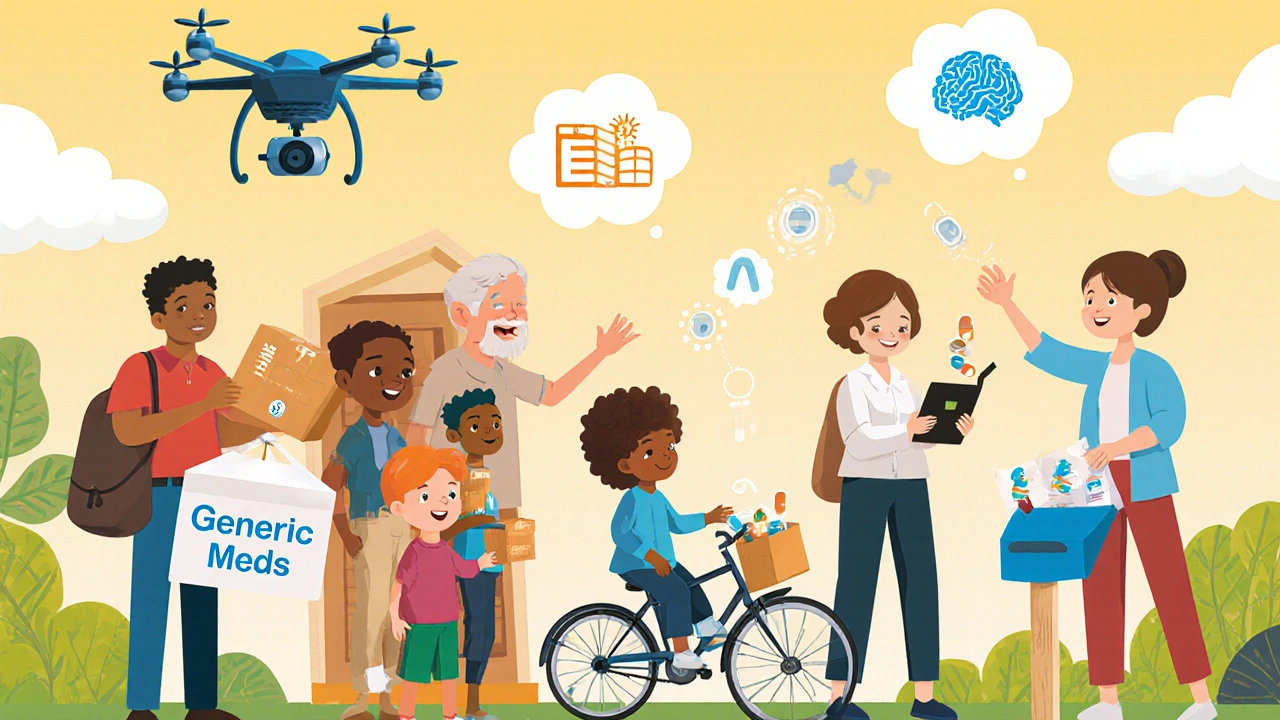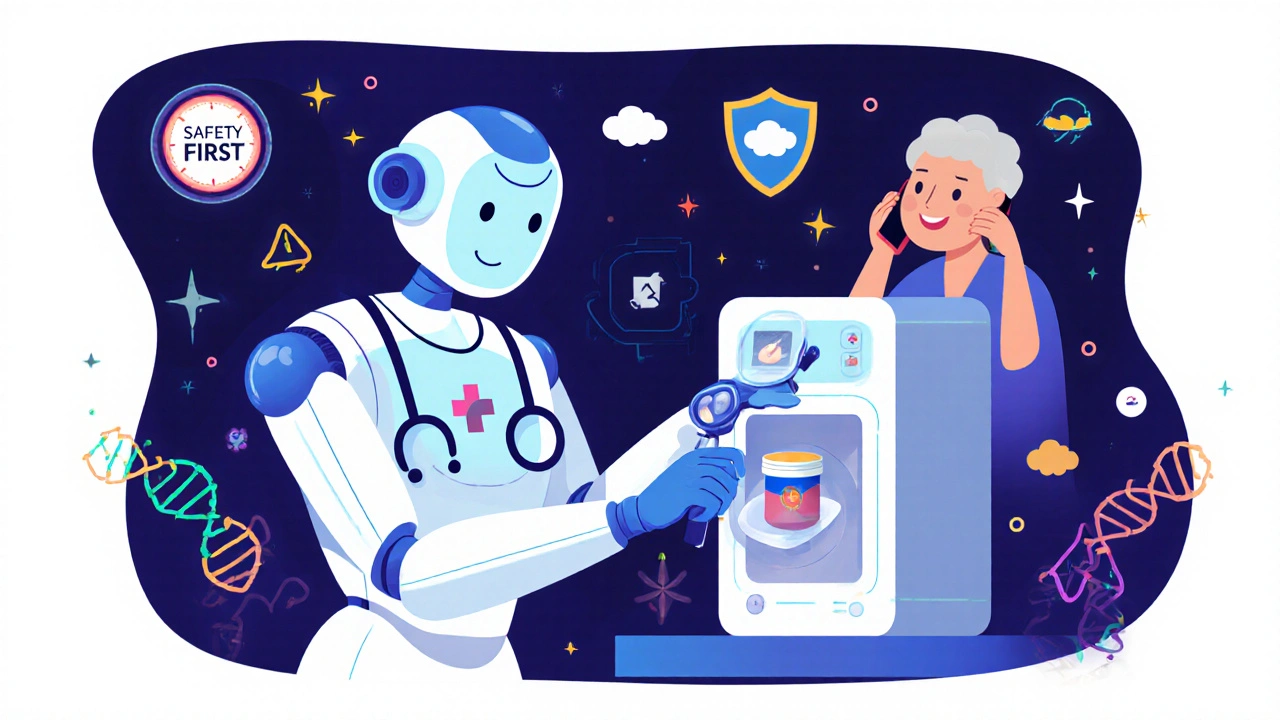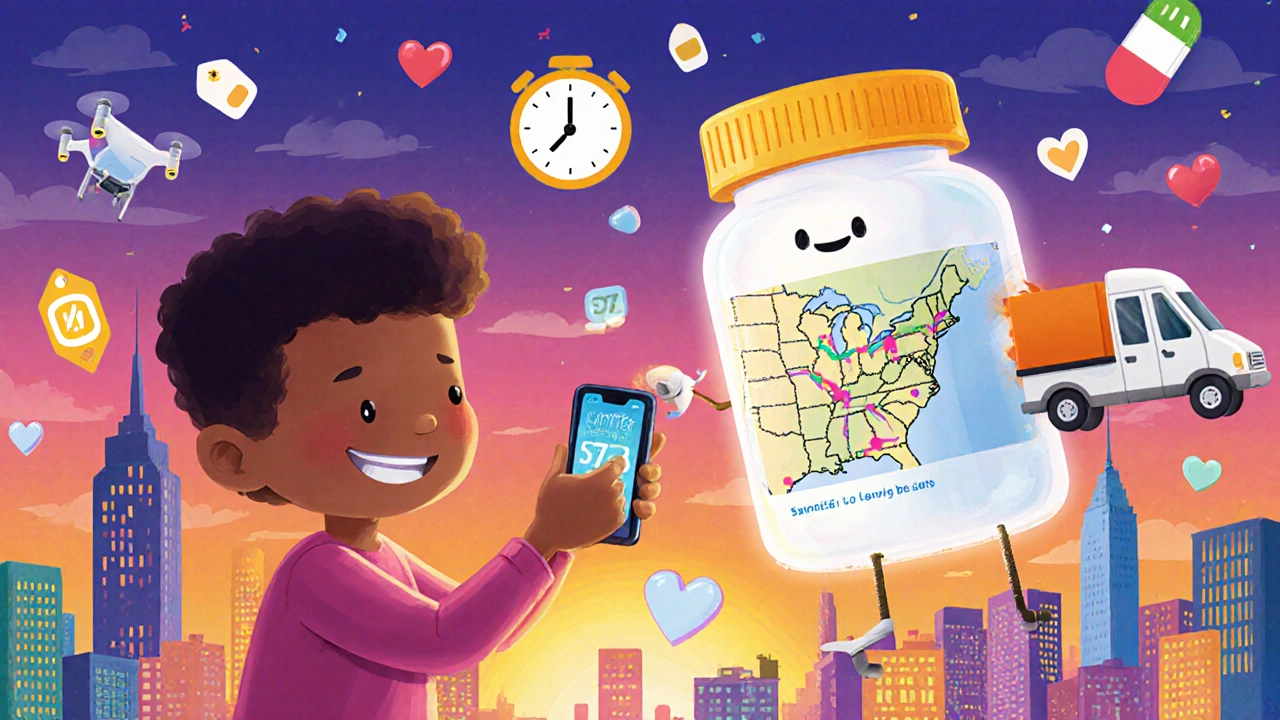By 2025, getting your generic meds won’t mean driving to a pharmacy, waiting in line, and hoping your insurance covers it. It’ll mean tapping your phone, getting a text that your pills are on the way, and knowing exactly how much you saved-no surprises. This isn’t science fiction. It’s already happening, and it’s changing how millions of Americans manage their health.
How We Got Here: From Mail-Order to Same-Day Delivery
Back in the early 2000s, online pharmacies were mostly for people who wanted to buy pills without a prescription. Today, the real shift is in generic medication delivery. The pandemic forced a massive leap forward. Between March 2020 and December 2021, telepharmacy use jumped 212%. Suddenly, people needed meds without leaving home. Pharmacies had to adapt-or lose customers.
Now, platforms like Truepill process over 10,000 prescriptions a day. CVS Health, Amazon Pharmacy, and startups like Ro and Blink Health aren’t just selling pills. They’re building systems that connect your virtual doctor visit to your doorstep in hours, not days. And the bulk of those prescriptions? Generics. In the U.S., 90% of all prescriptions filled are for generic drugs. That’s $124.7 billion a year in generic sales. Digital delivery is targeting that market hard because it’s where the volume-and the savings-are.
Speed, Savings, and Smart Tech: What’s Changed
Traditional pharmacies take about 48 hours to fill a routine prescription. Digital platforms? 5.2 hours on average. Same-day delivery is now standard in urban areas. In rural zones, it’s slower-around 38 hours-but still faster than driving 60 miles to the nearest pharmacy.
Cost savings are real. On average, digital generic delivery cuts prices by 22.7% compared to retail pharmacies, according to GoodRx’s 2024 report. For someone on a monthly blood pressure med, that’s $83 saved. Add in no gas, no parking, no time off work, and the value multiplies.
Behind the scenes, AI does the heavy lifting. Algorithms predict demand with 89.7% accuracy by tracking local flu outbreaks, seasonal allergies, even weather patterns. If a town gets hit with a bad cold season, the system automatically stocks up on cough syrup and acetaminophen generics. No human has to guess.
Platforms integrate directly with EHRs like Epic and Cerner. When your doctor e-prescribes a generic, the system checks your insurance in real time, confirms coverage, and routes the order to the nearest fulfillment center. No phone calls. No faxes. No waiting.
Who’s Winning the Market
The digital pharmacy space isn’t one big player-it’s a race between three types of competitors:
- Integrated Retailers: CVS Health (28.4% market share), Walgreens. They use their existing stores as hubs for local delivery.
- Pure Digital Players: Ro, Honeybee Health. Built from scratch, focused on convenience and user experience.
- Specialty Platforms: Blink Health. They don’t deliver-they’re price engines, showing you the lowest possible cash price for generics.
CVS leads because it combines physical presence with digital reach. But startups are catching up fast by offering cleaner apps, better customer service, and no hidden fees. Amazon’s advantage? Prime membership. If you’re already getting your groceries and books delivered, why not your meds too?

The Hidden Flaws: When the System Breaks
It’s not perfect. A Reddit user named ‘PharmaPatient87’ posted in March 2024: “Saved $83 a month-until they auto-substituted a generic my insurance didn’t cover.” That’s the dark side of automation.
AI-driven substitution can misfire. In 2023, an FDA safety alert reported 217 patients got the wrong dose of levothyroxine because a digital platform swapped generics without checking for narrow therapeutic index issues. Levothyroxine isn’t like ibuprofen. A tiny difference in formulation can cause serious side effects.
Only 43% of digital platforms offer full medication therapy management-the kind of personalized counseling you’d get from a pharmacist at your local drugstore. Most just ship pills. That’s fine for stable conditions like high blood pressure. But for someone on five different meds, with kidney issues and allergies? It’s risky.
And then there’s the human factor. 24% of seniors struggle with digital platforms. 37.8% of negative reviews on Trustpilot mention “no one to talk to.” Pharmacists aren’t just pill dispensers-they’re safety nets. When you’re confused about a new generic, you need someone to explain why it’s safe.
Regulations Are Catching Up
The law hasn’t kept pace with the tech. Right now, 28 states require the pharmacist filling your order to be licensed in your state. That’s a nightmare for national delivery networks. A patient in Texas can’t get a prescription filled by a pharmacist in California unless that pharmacist holds a Texas license.
Seventeen states have passed laws specifically about digital generic substitution. Some require explicit patient consent before switching. Others ban substitution for certain drugs entirely. The FDA’s 2023 Digital Health Innovation Action Plan is trying to create national standards, but it’s slow.
And cybersecurity? A big concern. In 2023, there were 378 pharmacy data breaches affecting over 14 million people. Digital platforms are prime targets because they hold everything: prescriptions, insurance info, health history. AES-256 encryption is standard, but breaches still happen through third-party vendors or employee mistakes.

What’s Coming Next: 2025 and Beyond
By 2025, AI will handle over half of prior authorization requests for generic meds. That’s down from 72 hours to under 4 hours. No more waiting days for approval from your insurer.
CVS Health’s SmartDUR™ system, rolling out in late 2024, will use AI to analyze whether a generic substitution is truly equivalent-not just chemically, but based on your genetic profile. That’s the next frontier: pharmacogenomics. By 2026, 74% of digital pharmacy platforms are expected to use your DNA data (with consent) to pick the best generic version for you.
Pharmacy schools are adapting. The University of Florida now requires all pharmacy students to take AI literacy courses focused on generic substitution algorithms. Future pharmacists won’t just memorize drug interactions-they’ll learn how to audit AI recommendations.
Smart pill dispensers are getting smarter too. Devices that beep when it’s time to take your meds now sync with apps and alert your doctor if you miss doses. Studies show they improve adherence by 28% for chronic conditions like diabetes and hypertension.
Who Benefits the Most-and Who Gets Left Behind
Younger adults (18-44) are driving adoption. 68.4% use digital generic delivery. They’re comfortable with apps, value speed, and hate paying full price. Older adults (65+)? Only 22.7% use them. Many don’t trust the tech. Others can’t navigate the apps. And for those on Medicare Part D, reimbursement cuts in 2024 made mail-order less attractive.
People in pharmacy deserts-36.7 million Americans, mostly in rural areas-are the biggest winners. No more skipping doses because the pharmacy is two counties away. Digital delivery bridges that gap.
But the system still fails people with complex regimens. If you’re on ten meds, have multiple specialists, and take drugs with narrow therapeutic windows, digital pharmacy isn’t ready for you yet. You still need the human touch.
Final Thoughts: Convenience Isn’t Everything
The future of digital pharmacy is bright-but only if we don’t trade safety for speed. The technology is here. The savings are real. The access is life-changing for millions.
But the best digital pharmacy isn’t the one that delivers fastest. It’s the one that knows when to pause. When to flag a substitution. When to connect you to a real pharmacist. When to say, “This isn’t right for you.”
AI can predict demand. It can cut costs. It can deliver pills in hours. But it can’t replace a pharmacist who’s seen you for years and knows your story. The future isn’t about replacing humans. It’s about empowering them-with better tools, better data, and more time to focus on what matters: your health.
Can I trust digital pharmacies to give me the right generic medication?
Most reputable digital pharmacies follow FDA standards and use FDA-approved generics. But automation can sometimes make mistakes-especially with drugs that have narrow therapeutic windows, like levothyroxine or warfarin. Always check the label and confirm with your doctor if you notice a change in how you feel after switching to a new generic. Platforms like CVS and Amazon have better oversight than smaller startups.
Are digital generic delivery services cheaper than my local pharmacy?
Yes, for most people. On average, digital platforms offer 22.7% lower prices for generics than brick-and-mortar pharmacies, according to GoodRx. You also save on transportation, parking, and time off work. But always compare prices using tools like GoodRx or SingleCare. Sometimes your local pharmacy’s loyalty program or coupon beats the online price.
Can seniors use digital pharmacy services easily?
It’s harder for many seniors. 24% report difficulty using apps or websites. Some platforms offer phone support or family account access, which helps. Look for services with large buttons, voice navigation, and live pharmacist chat. CVS and Walgreens have dedicated senior-friendly interfaces. If you’re not tech-savvy, ask a family member to set up your account or stick with your local pharmacy for now.
Do digital pharmacies accept my insurance?
Most major digital pharmacies accept Medicare Part D, Medicaid, and private insurance. But not all plans work with every platform. Insurance verification fails in about 18% of first attempts. If your insurance doesn’t process, the platform will usually show you the cash price-which is often still cheaper than retail. Always double-check coverage before ordering.
Will AI replace pharmacists in digital pharmacies?
No. AI handles routine tasks: checking stock, verifying insurance, suggesting generics. But pharmacists still review complex cases, catch errors, and answer questions. The role is changing-not disappearing. The best digital pharmacies use AI to free up pharmacists to do more counseling, not less.
How fast can I get my meds delivered?
In urban areas, same-day delivery is common-often within 5 hours of ordering. In rural areas, it takes longer, usually 24-38 hours. Some services guarantee delivery within 2 hours for a fee. Always check the estimated delivery time before you order. Same-day doesn’t mean instant.
What should I do if I get the wrong medication?
Stop taking the medication immediately. Call the pharmacy’s customer service and your doctor. Most reputable platforms have 24/7 support and will send a return label and replacement at no cost. Report the error to the FDA’s MedWatch program. Document everything-photos of the pills, packaging, and your prescription. This helps prevent others from getting the same mistake.
Are digital pharmacies safe for controlled substances?
Yes, but with strict rules. Controlled substances like opioids or ADHD meds require an in-person or video consultation with a licensed provider before being prescribed. Digital pharmacies use identity verification and e-prescription tracking to prevent abuse. If a platform offers controlled substances without a real consultation, avoid it-it’s likely illegal.
By 2027, digital channels will handle nearly half of all generic medication dispensing in the U.S. That’s a massive shift. But the goal shouldn’t be to replace the pharmacy. It’s to make sure no one has to choose between their health and their time, money, or access.


OMG I got my blood pressure meds delivered in 3 HOURS and they charged me $3. I thought I was dreaming. Then I realized they sent me the wrong bottle-like, literally, I opened it and it was insulin. I’m not even diabetic. I called and they said ‘AI thought you might need it.’ I’m filing a lawsuit. Or maybe a TikTok. 🤯
THIS IS A GOVERNMENT BIOMETRIC TRACKING SCHEME. They’re not delivering pills-they’re delivering RFID chips that track your vital signs and feed data to the NSA. You think the ‘AI’ is just predicting demand? No. It’s predicting when you’ll die. And then your insurance drops you. Wake up, sheeple. The pills are laced with microchips. I’ve seen the blueprints. 🔍
If you’re not checking the label every time, you’re asking for trouble. I lost my aunt to a bad generic swap. No one apologized. Just a $5 coupon. 🙄
Bro, in India we still wait 3 days for a prescription. You guys are getting AI-powered meds delivered faster than my chai gets cold. 😍 But seriously, why isn’t this tech in developing countries? Is it because Big Pharma wants us to suffer? 🤔
Actually, most of the cost savings come from cutting out pharmacist labor, not from efficiency. The AI doesn’t care if you’re allergic to sulfites. It just sees ‘generic’ and hits ‘approve.’ You’re trading safety for convenience. And convenience is just capitalism in yoga pants. 🧘♀️
I’ve been using Blink Health for my cholesterol meds for a year. Never had an issue. But I do miss the old guy at the counter who always asked how my dog was doing. That human touch? Priceless. Still, I’ll take the $70 savings over small talk any day.
USA thinks it’s so advanced. We in India have been delivering medicines via drone since 2020. You’re still arguing about AI substitutions? We’re dropping insulin in villages where no road exists. Your ‘revolution’ is just a marketing slogan. 🇮🇳💪
Let me be clear: if you let Amazon fill your prescriptions, you’re letting the same company that sells your baby’s diapers track your blood pressure, your mental health meds, and your STD treatments. They own your data. They own your body. This isn’t innovation-it’s colonization. And it’s happening right under your nose.
so i used truepill last month and it was great until my anxiety med got switched and i felt like i was melting inside? called them and they said ‘system error’ and sent a new bottle. no apology. no call from a pharmacist. just a bot saying ‘thanks for your patience.’ i’m scared to use it again. 🙏
You think this is progress? This is the slow-motion implosion of healthcare. You hand over your life to algorithms that don’t know the difference between levothyroxine and a placebo, and you call it ‘convenience.’ You’re not saving time-you’re gambling with your life. And when your kidneys fail because a bot swapped your meds? You’ll be begging for a pharmacist who remembers your name. Spoiler: they’ll be gone by then.
They’re not delivering pills. They’re delivering surveillance. Every time you click ‘order,’ you’re giving Big Pharma your DNA, your habits, your fears. And when your insurance drops you after your AI ‘predicts’ you’ll get cancer? You’ll be crying in the parking lot of your local pharmacy… if it hasn’t been shut down by then. I told you this was coming. I told you. 😭
There’s something beautiful about the fact that we’re automating the most human part of care-the dispensing of medicine. We’ve outsourced trust to code. But maybe that’s the tragedy. We used to rely on the pharmacist because they knew us. Now we rely on them because they’re the last human left in the chain. And if we lose them too? What’s left? A machine that gives you pills but doesn’t ask if you’re okay.
According to the 2023 FDA Digital Health Innovation Action Plan (DHIA-2023-01), the current regulatory framework is fundamentally incompatible with nationwide digital pharmacy logistics due to state-specific licensure requirements (28 U.S. Code § 1301.12), which create logistical bottlenecks that reduce system-wide efficiency by an estimated 31.4%. Until federal preemption is enacted, we are merely patching a broken system with AI glitter.
I’m from rural Maine. My mom’s on five meds. She doesn’t use a phone. But last month, my sister set up a family account with CVS and now they deliver her pills every two weeks. A real pharmacist called her last week just to check in. She cried. Said it felt like someone cared. That’s what this is really about-not speed or savings. It’s about not being alone. And yeah, the tech helps. But the heart? That’s still human. And we can’t let that go.